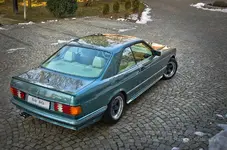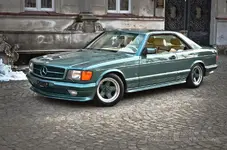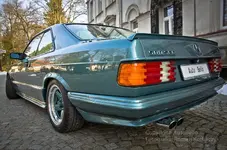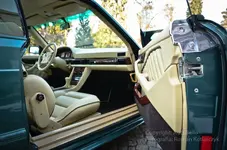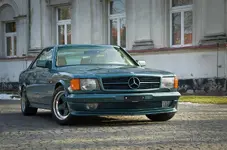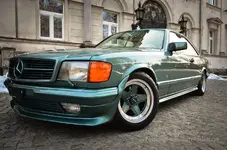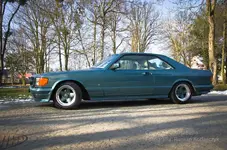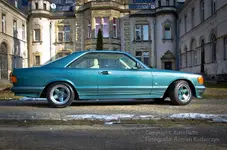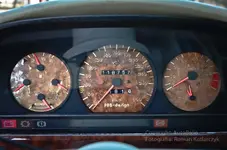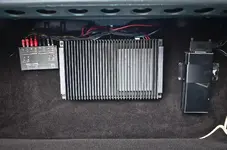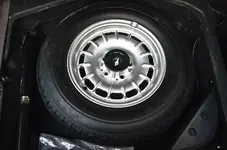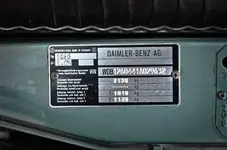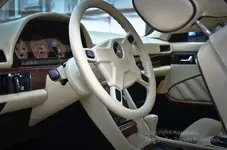Giannis
Staff member
Modern classics: the Coupes of the Mercedes-Benz 126 series (1981 to 1991)

Stuttgart - Mercedes-Benz Coupés have always embodied elegance on four wheels. And exclusivity besides, since the vehicles attract a clientele that consciously opts for a body form with flowing lines, the classic two doors and who to a certain extent see their vehicle as a logical extension of a lifestyle often characterised by beauty and elegance.
These fundamentals also applied to the SEC Coupés of the C 126 series, which Mercedes-Benz presented at the Frankfurt International Motor Show (IAA) in September 1981. They were based on the S-Class Saloon of the 126 series, with a frame/floor assembly shortened by 85 millimetres. Nevertheless, the Coupés were fully-fledged four-seaters.
Their design rendered them unmistakable: Bruno Sacco, then Head of Design, gave the vehicles the perfect lines of the day and also integrated them harmoniously into the Mercedes-Benz passenger car range. For example, he revived the horizontal radiator grille with large central star which had been a feature of the large Mercedes-Benz Coupés and the legendary 300 SL Gullwing Coupé since the 1950s. All things considered, the Coupés of the C 126 series were a tour de force in terms of design, retaining even today an air of timeless elegance and desirability.
The elegant looks of the Coupés were coupled with exclusive equipment, powerful engines and optimum safety – resulting in an experience that offered comfort from every facet of automotive design. Even the longest journeys could be effortlessly undertaken in the Coupé, thanks to its sophisticated chassis – which apart from a few details was identical to that of the S-Class – the ergonomically designed and elegant interior and the drive system. The Coupés were available exclusively with eight-cylinder engines. Initially there were two models, the 380 SEC and 500 SEC. The model refinement package in 1985 saw the 380 SEC superseded by the 420 SEC, as well as the arrival of a modified version of 500 SEC and – the most spectacular newcomer – the 560 SEC. The model refinement package also saw the introduction of emission control systems with a closed-loop three-way catalytic converter.
In terms of safety technology the Coupés of the C 126 series were state-of-the-art. The body was designed in line with latest safety research findings. One noteworthy equipment detail was the electrically operated belt feeder, which was a standard-fit specification on the SEC models. Optionally available were also an airbag for the driver and belt tensioner for the front passenger. The front passenger airbag was available from 1985. Optimum active driving safety was guaranteed by systems such as the automatic locking differential (ASD) or acceleration skid control (ASR).
Value retention as opposed to depreciation
The range of Coupés sporting the desirable SEC abbreviation in the model designation is extensive. Although most of them are by now older vehicles, it is not unusual to fine well maintained examples. Moreover, high mileages are no problem for the regularly maintained eight-cylinder engines.
But there are also vehicles available with a manufacturer’s warranty: Mercedes-Benz Young Classics regularly offers vehicles in above average condition and which are therefore supplied with a warranty – an offer unique in the automotive industry.
Those who today drive a Coupé of the C 126 series as a modern classic are sure to appreciate aspects such as its outstanding everyday practicality, high level of ride comfort, elegant appearance and exclusivity. An additional bonus is that with correct maintenance and good care it will at least retain its value and eliminate depreciation. In many cases, the value of the vehicle even rises over time.
Mercedes-Benz’s excellent spare parts supply has helped maintain a modern classic: almost every part can be procured through a Mercedes-Benz dealer and the company’s own ordering system; delivery is usually made overnight. Some authorised service shops have even been designated Classic Partners, possessing outstanding competence in handling older vehicles. Not for nothing does the slogan “Service for a lifetime” apply to all vehicles of the brand.
Production of the Coupés of the C 126 series was stopped in 1991, almost exactly ten years after the market launch. The total volume of 74,060 units built gives an impression of the model family’s high popularity. The best-selling model was the 500 SEC with 30,184 units.
Clearly the rarest version was the 420 SEC with just 3,680 units. Regardless of engine type, each individual vehicle is a legend of its time.



Full Gallery, here: http://www.nospeedlimit.com/modern-classics-the-coupes-of-the-mercedes-benz-126-series-1981-to-1991
- Still attractive and desirable
- Innovation studies of their day
- High value retention as modern classics
Stuttgart - Mercedes-Benz Coupés have always embodied elegance on four wheels. And exclusivity besides, since the vehicles attract a clientele that consciously opts for a body form with flowing lines, the classic two doors and who to a certain extent see their vehicle as a logical extension of a lifestyle often characterised by beauty and elegance.
These fundamentals also applied to the SEC Coupés of the C 126 series, which Mercedes-Benz presented at the Frankfurt International Motor Show (IAA) in September 1981. They were based on the S-Class Saloon of the 126 series, with a frame/floor assembly shortened by 85 millimetres. Nevertheless, the Coupés were fully-fledged four-seaters.
Their design rendered them unmistakable: Bruno Sacco, then Head of Design, gave the vehicles the perfect lines of the day and also integrated them harmoniously into the Mercedes-Benz passenger car range. For example, he revived the horizontal radiator grille with large central star which had been a feature of the large Mercedes-Benz Coupés and the legendary 300 SL Gullwing Coupé since the 1950s. All things considered, the Coupés of the C 126 series were a tour de force in terms of design, retaining even today an air of timeless elegance and desirability.
The elegant looks of the Coupés were coupled with exclusive equipment, powerful engines and optimum safety – resulting in an experience that offered comfort from every facet of automotive design. Even the longest journeys could be effortlessly undertaken in the Coupé, thanks to its sophisticated chassis – which apart from a few details was identical to that of the S-Class – the ergonomically designed and elegant interior and the drive system. The Coupés were available exclusively with eight-cylinder engines. Initially there were two models, the 380 SEC and 500 SEC. The model refinement package in 1985 saw the 380 SEC superseded by the 420 SEC, as well as the arrival of a modified version of 500 SEC and – the most spectacular newcomer – the 560 SEC. The model refinement package also saw the introduction of emission control systems with a closed-loop three-way catalytic converter.
In terms of safety technology the Coupés of the C 126 series were state-of-the-art. The body was designed in line with latest safety research findings. One noteworthy equipment detail was the electrically operated belt feeder, which was a standard-fit specification on the SEC models. Optionally available were also an airbag for the driver and belt tensioner for the front passenger. The front passenger airbag was available from 1985. Optimum active driving safety was guaranteed by systems such as the automatic locking differential (ASD) or acceleration skid control (ASR).
Value retention as opposed to depreciation
The range of Coupés sporting the desirable SEC abbreviation in the model designation is extensive. Although most of them are by now older vehicles, it is not unusual to fine well maintained examples. Moreover, high mileages are no problem for the regularly maintained eight-cylinder engines.
But there are also vehicles available with a manufacturer’s warranty: Mercedes-Benz Young Classics regularly offers vehicles in above average condition and which are therefore supplied with a warranty – an offer unique in the automotive industry.
Those who today drive a Coupé of the C 126 series as a modern classic are sure to appreciate aspects such as its outstanding everyday practicality, high level of ride comfort, elegant appearance and exclusivity. An additional bonus is that with correct maintenance and good care it will at least retain its value and eliminate depreciation. In many cases, the value of the vehicle even rises over time.
Mercedes-Benz’s excellent spare parts supply has helped maintain a modern classic: almost every part can be procured through a Mercedes-Benz dealer and the company’s own ordering system; delivery is usually made overnight. Some authorised service shops have even been designated Classic Partners, possessing outstanding competence in handling older vehicles. Not for nothing does the slogan “Service for a lifetime” apply to all vehicles of the brand.
Production of the Coupés of the C 126 series was stopped in 1991, almost exactly ten years after the market launch. The total volume of 74,060 units built gives an impression of the model family’s high popularity. The best-selling model was the 500 SEC with 30,184 units.
Clearly the rarest version was the 420 SEC with just 3,680 units. Regardless of engine type, each individual vehicle is a legend of its time.
Full Gallery, here: http://www.nospeedlimit.com/modern-classics-the-coupes-of-the-mercedes-benz-126-series-1981-to-1991








